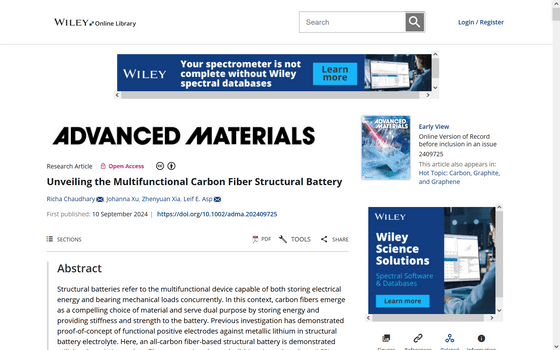'World's strongest battery' developed that could extend EV range by 70% and make smartphones as thin as credit cards

by Chalmers University of Technology | Henrik Sandsjö
A lightweight yet highly rigid battery has been developed that can not only store energy but also support heavy loads. If development progresses, it could contribute to making batteries even thinner.
Unveiling the Multifunctional Carbon Fiber Structural Battery - Chaudhary - Advanced Materials - Wiley Online Library

World's strongest battery paves way for light | EurekAlert!
Sweden: World's strongest battery could increase EV range by 70%
https://interestingengineering.com/energy/worlds-strongest-structural-battery-sweden
The battery developed by Leif Asp and others at Chalmers University of Technology in Sweden is a type of 'structural battery' that has both load-bearing and energy storage functions.
In 2018, Asp and his colleagues discovered that carbon fibers can store electrical energy and can be used as electrodes in lithium-ion batteries. They created a lithium-ion battery with carbon fibers in both the positive and negative electrodes. By 2021, they will be able to improve the strength and electrical capacity of the battery to achieve an energy density of 24Whr/kg.
This time, the researchers changed the material coating the battery core from aluminum foil to lithium iron phosphate, and increased the energy density to 30Wh/kg. The rate has been increased from 25 GPa to 70 GPa, making it possible to support heavy objects like aluminum. Another feature is that it is lightweight because it does not use materials such as copper or aluminum. Then there is the issue of lack of power.
Although the value of 30Wh/kg is very low compared to existing lithium-ion batteries, it is lighter than existing batteries, so if it is applied to electric vehicles, for example, the reduced weight could extend the driving range. There is.

by Chalmers University of Technology | Henrik Sandsjö
In addition, lithium ions are transported between the battery terminals through a semi-solid electrolyte rather than a liquid electrolyte, which reduces the risk of fire and improves battery safety. .
'There's still a lot of work to be done to move from small-scale manufacturing in laboratories to large-scale production for tech gadgets and vehicles,' Asp said. 'But we're well on our way to getting to smartphones as thin as a credit card or half the size of today's devices.' 'It's not hard to imagine a laptop weighing that much in the near future.'
Related Posts:
in Hardware, Posted by log1p_kr







